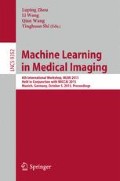Abstract
In this study, we propose a novel sparse regression based random forest (RF) to predict future clinical scores of Alzheimer’s disease (AD) with the baseline scores and the MRI features. To avoid the stair-like decision boundary caused by axis-aligned split function in the conventional RF, we present a supervised method to construct the oblique split function by using sparse regression to select the informative features and transform the original features into the target-like features that are more discriminative. Then, we construct the oblique splitting function by applying the principal component analysis (PCA) on the transformed target-like features. Furthermore, to reduce the negative impact of potential mis-split induced by the conventional “hard-split”, we further introduce the “soft-split” technique, in which both left and right nodes are visited with certain weights given a test sample. The experiment results show that sparse regression based RF alone can improve the prediction performance of the conventional RF. And further improvement can be achieved when both of the techniques are combined.
This work was supported by the National Institute of Health grants EB006733, EB008374, EB009634, AG041721, MH100217, and AG042599.
Preview
Unable to display preview. Download preview PDF.
References
Li, J., Jin, Y., Shi, Y., Dinov, I.D., Wang, D.J., Toga, A.W., Thompson, P.M.: Voxelwise spectral diffusional connectivity and its applications to alzheimer’s disease and intelligence Prediction. In: Mori, K., Sakuma, I., Sato, Y., Barillot, C., Navab, N. (eds.) MICCAI 2013, Part I. LNCS, vol. 8149, pp. 655–662. Springer, Heidelberg (2013)
Zhan, L., et al.: Comparison of nine tractography algorithms for detecting abnormal structural brain networks in Alzheimer’s disease. Front. Aging Neurosci. 7, 48 (2015)
Zhan L., et al.: Multiple stages classification of alzheimer’s disease based on structural brain networks using generalized low rank approximations (GLRAM). In: MICCAI Computation Diffusion MRI, Mathematics and Visualization, pp. 35–44 (2014)
Jin Y., et al.: Automated multi-atlas labeling of the fornix and its integrity in Alzheimer’s disease. In: Proc IEEE Int Symp Biomed Imaging, pp. 140–143 (2015)
Petrella, J.R., et al.: Neuroimaging and early diagnosis of Alzheimer disease: a look to the future. Radiology 226(2), 315–336 (2003)
Zhu, X., et al.: Matrix-similarity based loss function and feature selection for Alzheimer’s disease diagnosis. In: IEEE Conf on CVPR, pp. 3089–3096 (2014)
Zhu, X., Suk, H.-I., Shen, D.: A novel multi-relation regularization method for regression and classification in AD diagnosis. In: Golland, P., Hata, N., Barillot, C., Hornegger, J., Howe, R. (eds.) MICCAI 2014, Part III. LNCS, vol. 8675, pp. 401–408. Springer, Heidelberg (2014)
Breiman, L.: Random forests. Machine learning 45(1), 5–32 (2001)
Menze, B.H., Kelm, B., Splitthoff, D.N., Koethe, U., Hamprecht, F.A.: On oblique random forests. In: Gunopulos, D., Hofmann, T., Malerba, D., Vazirgiannis, M. (eds.) ECML PKDD 2011, Part II. LNCS, vol. 6912, pp. 453–469. Springer, Heidelberg (2011)
Tzourio-Mazoyer, N., et al.: Automated anatomical labeling of activations in SPM using a macroscopic anatomical parcellation of the MNI MRI single-subject brain. Neuroimage 15(1), 273–289 (2002)
Duchesne, S., et al.: Relating one-year cognitive change in mild cognitive impairment to baseline MRI features. Neuroimage 47(4), 1363–1370 (2009)
Stonnington, C.M., et al.: Predicting clinical scores from magnetic resonance scans in Alzheimer’s disease. Neuroimage 51(4), 1405–1413 (2010)
Author information
Authors and Affiliations
Corresponding authors
Editor information
Editors and Affiliations
Rights and permissions
Copyright information
© 2015 Springer International Publishing Switzerland
About this paper
Cite this paper
Huang, L., Gao, Y., Jin, Y., Thung, KH., Shen, D. (2015). Soft-Split Sparse Regression Based Random Forest for Predicting Future Clinical Scores of Alzheimer’s Disease. In: Zhou, L., Wang, L., Wang, Q., Shi, Y. (eds) Machine Learning in Medical Imaging. MLMI 2015. Lecture Notes in Computer Science(), vol 9352. Springer, Cham. https://doi.org/10.1007/978-3-319-24888-2_30
Download citation
DOI: https://doi.org/10.1007/978-3-319-24888-2_30
Published:
Publisher Name: Springer, Cham
Print ISBN: 978-3-319-24887-5
Online ISBN: 978-3-319-24888-2
eBook Packages: Computer ScienceComputer Science (R0)

